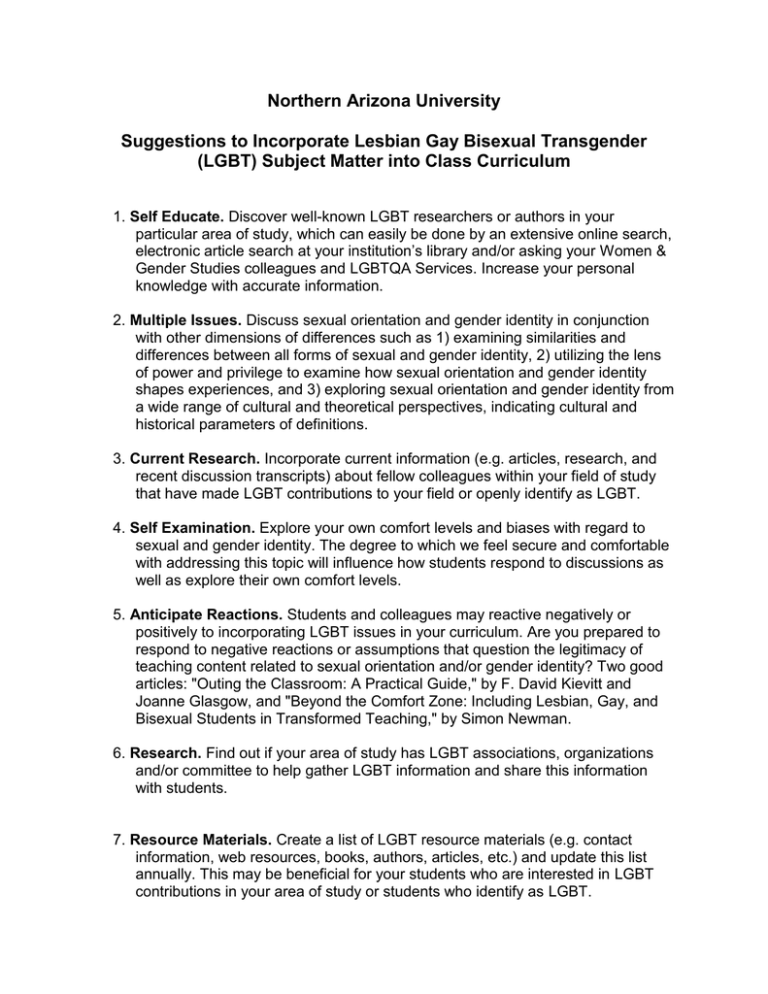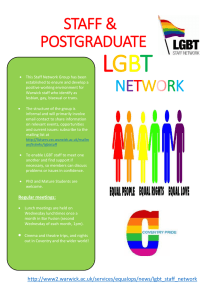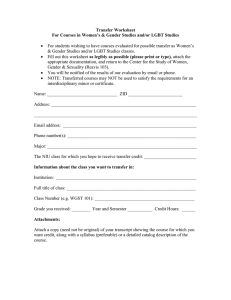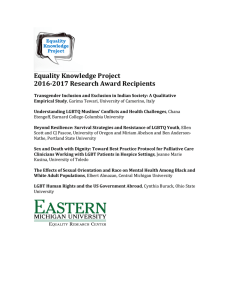
Northern Arizona University
Suggestions to Incorporate Lesbian Gay Bisexual Transgender
(LGBT) Subject Matter into Class Curriculum
1. Self Educate. Discover well-known LGBT researchers or authors in your
particular area of study, which can easily be done by an extensive online search,
electronic article search at your institution’s library and/or asking your Women &
Gender Studies colleagues and LGBTQA Services. Increase your personal
knowledge with accurate information.
2. Multiple Issues. Discuss sexual orientation and gender identity in conjunction
with other dimensions of differences such as 1) examining similarities and
differences between all forms of sexual and gender identity, 2) utilizing the lens
of power and privilege to examine how sexual orientation and gender identity
shapes experiences, and 3) exploring sexual orientation and gender identity from
a wide range of cultural and theoretical perspectives, indicating cultural and
historical parameters of definitions.
3. Current Research. Incorporate current information (e.g. articles, research, and
recent discussion transcripts) about fellow colleagues within your field of study
that have made LGBT contributions to your field or openly identify as LGBT.
4. Self Examination. Explore your own comfort levels and biases with regard to
sexual and gender identity. The degree to which we feel secure and comfortable
with addressing this topic will influence how students respond to discussions as
well as explore their own comfort levels.
5. Anticipate Reactions. Students and colleagues may reactive negatively or
positively to incorporating LGBT issues in your curriculum. Are you prepared to
respond to negative reactions or assumptions that question the legitimacy of
teaching content related to sexual orientation and/or gender identity? Two good
articles: "Outing the Classroom: A Practical Guide," by F. David Kievitt and
Joanne Glasgow, and "Beyond the Comfort Zone: Including Lesbian, Gay, and
Bisexual Students in Transformed Teaching," by Simon Newman.
6. Research. Find out if your area of study has LGBT associations, organizations
and/or committee to help gather LGBT information and share this information
with students.
7. Resource Materials. Create a list of LGBT resource materials (e.g. contact
information, web resources, books, authors, articles, etc.) and update this list
annually. This may be beneficial for your students who are interested in LGBT
contributions in your area of study or students who identify as LGBT.
8. Incorporate. Utilize the research incorporating LGBT perspectives. You could
incorporate readings into your syllabus and/or web-sites including LGBT books,
bibliographies and reading lists.
9. Stay informed. This task can easily be designated to research assistants who
compile a list or prevalent LGBT contributions in your field of study.
10. Responsiveness. Establish guidelines for respectful classroom dialogue. You
can interrupt inappropriate language, stop insensitive jokes, and address
inappropriate behaviors.
11. Inclusive. Be inclusive to LGBT people. You may want to review terminology in
the LGBT community. For example, you could use gender neutral terms such as
partner instead of husband or wife; mention sexual orientation when appropriate - make it visible; include information about sexual orientation of historical and
cultural figures.
12. Do not make Assumptions. Don't make assumptions about anyone's sexual
orientation and/or gender identity. Rely on self-identification and respect
confidentiality and the right to self-disclosure.
13. Be a Visible Ally. Take the initiative and make it visible that you are LGBT
friendly by modeling supportive and affirming behaviors such as language you
use and/or the examples and even when you decorate your office and the books
on your shelves.
14. Course Visibility. After incorporating LGBT curriculum components into your
course submit the syllabi and ask for it to be included as an LGBT Certificate
elective. Next, post the ASU LGBT module on your course blackboard in order to
increase the visibility of LGBTQ resources at ASU for students.
Document adapted from University of Southern California, Lesbian Gay Bisexual
Transgender Resource Center.



